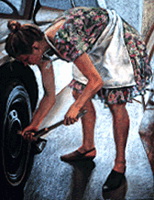Degas followed a long line of European artists who were enamored with pastels. Leonardo da Vinci used black and red chalk with yellow pastel highlights to complete a portrait drawing of "Isabelle d'Este, Duchess of Mantua" in 1499. According to historian Geneviève Monnier, da Vinci learned what he referred to as "the dry coloring method" from French artist Jean Perréal.
In France, pastel painting grew to enjoy great popularity through the proliferation of the so-called three-crayon portrait drawn in black, red and white chalk on toned paper. By the 17th century highly refined finished portraits were being executed by a number of artists using a broad range of colors which rivaled the palettes of many oil painters.
During the 1720s, the innovative Venetian artist Rosalba Carriera turned to pastel as the sole medium for her society portraits of Italian and French women.
Degas was among many working in pastel during the late 19th and early 20th centuries. Other pastel painters include Edouard Manet, James McNeill Whistler, Mary Cassatt and Odilon Redon.
These artists, who were trying to excite the human eye and arrest the fleeting visual and emotional effects of a world in constant motion, found pastel to be the perfect medium.
It is ironic that the same medium used for its ability to capture the immediacy of a momentary gesture or luminous mood has truly ancient origins.
The use of dry pigments in various physical states began with the earliest hominids. Neanderthal burial sites reaching back 40,000 years reveal funerary rituals which included the sprinkling of fresh flower petals and dry red ochre on the corpse.
Cave paintings in Lascaux, France, dating back more than 15,000 years, utilized charcoal and both wet and dry pigments to render huge animals on the vaulted ceilings. Presumably drawn and painted by torch-light, these early pictorials employ methods and materials similar to those used by pastel painters.
The human hand imprint is found in caves and on cliff faces around the world. Dry materials, such as powdered charcoal or mineral pigments were dusted over the back of the hand placed over the target surface prepared with a coating of saliva, animal fat or tree resin.
In Britain, trenches dug into white chalk based hillsides were used by early Iron Age people to form gigantic outline drawings depicting a highly stylized horse in Berkshire, England, a human figure in Wilmington, England and a nude male warrior wielding a club spanning 180 feet on a hillside in Dorset.
Some historians credit prehistoric people with the manufacture of early pastel sticks packed by hand into hollow animal bones. The bones were left near the fire until the pigment laden paste dried and shrank for easy removal.
Dry stick, Conté crayon, oil pastel and pencil pastels now form an aesthetic and technical bridge between drawing and painting. Originally employed by artists to work out compositional and color problems in preparation to painting with oil, the use of pastels evolved into a unique painting medium.
Made from precipitated chalk, dry pigments and a binder (traditionally Gum tragacanth derived from Asian legume plants), modern pastels have been in constant use since the Renaissance.

Image: © David L. Wallach
"Woolworths"
Soft Pastel 20" x 12" |
Precipitated chalk, the essential constituent of pastels, is produced from geologically ancient soft sedentary limestone containing the shells of billions of dead marine protozoan. The limestone is finely ground in water and allowed to settle. The water is poured off and the resulting powdered paste is left to dry. Tonal ranges are created from various amounts of pigment blended with chalk paste.
From cave paintings and earthworks to Da Vinci, Pablo Picasso and Willem de Kooning, pastel styles and subjects cover the entire aesthetic spectrum.
Award-winning contemporary Albuquerque artist David L. Wallach came to use pastel for his self-described "primitive realism" through the evolution of his traditional impressionistic style. When asked the how and why of works like his stunning depiction of the empty seats at the now closed Woolworth's lunch counter on the Santa Fe Plaza, Wallach is matter of fact.
"I began pastel painting in a much looser manner than I now use. I prefer to work from my own photographs which I use as a sketchbook. In the case of the Woolworths piece I went back several times to take mental notes and refresh my memory of the scene. I worked on waterproof sand paper which I underpainted with watercolor. I then applied and blended the pastels," Wallach said.
|
Nancy Kozikowski, who is best known for her abstract weavings, is another contemporary New Mexico artist working in pastels. For figure paintings and portraits she chooses to work on black textured paper in a style similar to New York painter Eric Fischl. Kozikowski also uses pastels to create preliminary color and design studies for her non-objective tapestries.
Pastels are most widely used by neo-impressionists and neo-expressionists who focus on traditional subjects and themes. As a means of developing and sharing their craft pastel artists have formed groups all over the world. On a local level, the Pastel Society of New Mexico generates exhibitions, publishes a newsletter and offers workshops for artists. The Society also sponsors an annual national exhibition.
Collectors, who have long appreciated pastel renderings, can rest assured that their selections can survive the rigors of time. If traditional dry pigments (which do not incorporate dyes), high quality binders and fine papers are used by the artist, pastel works are among the most permanent of painting techniques.
Art materials expert Ralph Mayer author of The Artist's Handbook wrote, "Framed under glass and given the care that any work of art normally receives, (pastel) portraits of the 1750 period have come down to us as bright and fresh as the day they were painted." |


